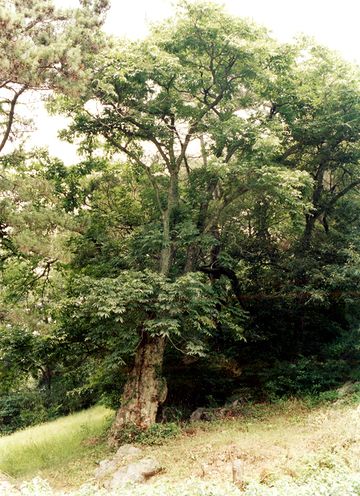진도 초하리 무환자나무
| 진도초하리무환자나무 Indian Soapberry of Choha-ri, Jindo |
|
 진도 초하리 무환자나무, 국가문화유산포털, 문화재청. |
|
| 대표명칭 | 진도초하리무환자나무 |
|---|---|
| 영문명칭 | Indian Soapberry of Choha-ri, Jindo |
| 한자 | 珍島草下里無患樹 |
| 주소 | 전라남도 진도군 의신면 초하리 산41-1 |
| 지정(등록) 종목 | 전라남도 기념물 제216호 |
| 지정(등록)일 | 2002년 11월 27일 |
| 분류 | 자연유산/천연기념물/생물과학기념물/생물상 |
| 수량/면적 | 1주(896㎡) |
| 웹사이트 | 진도 초하리 무환자나무, 국가문화유산포털, 문화재청. |
|
|
|
해설문
국문
이 나무는 심으면 자식에게 화가 미치지 않는다고 하여 무환자나무라 불리며, 우리나라 남부 지역의 사찰과 마을 근처에서 볼 수 있는 낙엽 교목이다. 5∼6월에 지름 4∼5mm의 황록색 꽃이 피며, 열매는 둥글고 10월에 황갈색으로 익는다. 옛날에는 열매의 껍질을 비누로 썼다.
이 나무는 높이 21~22m, 가슴 높이 지름 90~96cm에 이르는 노거수*이며, 나이는 약 600년으로 추정하고 있다. 마을에서는 정월 대보름날에 이 나무 밑에서 달이 떠오르는 모양을 보고 그해의 풍년과 흉년을 점치기도 했다고 한다. 가까운 절의 스님들은 이 나무의 씨앗으로 염주를 만들어 불공을 드리면 절이 번영한다고 믿어 나무에 정성을 들였다고 전해진다.
- 노거수(老巨樹): 나무의 나이가 많고 큰 나무
영문
Indian Soapberry of Choha-ri, Jindo
Indian soapberry (Sapindus mukorossi) is a deciduous tree in the family Sapindaceae, which mainly grows in the southern region of South Korea. It has yellowish green flowers measuring 4-5 mm in diameter that blossom between May and June, and bears round fruits that ripen to a light brown color in October. In the past, the skin of the fruits were used as soap, and people in the temples made Buddhist prayer beads out of the seeds.
The Indian soapberry of Choha-ri is estimated to be around 600 years old and measures 21-22 m in height and 90-96 cm in diameter at chest level. During the annual festival celebrating the first full moon of the lunar new year, the people from the village would gather under the tree, watch the moonrise, and predict the coming year’s harvest. It was also believed that if monks from nearby temples made Buddhist prayer beads out of the seeds of this tree and prayed using them, the temple would prosper, and thus the tree was cherished by the local monks.
영문 해설 내용
무환자나무는 무환자나무과의 낙엽교목으로, 주로 한국 남부 지역에서 볼 수 있다. 5~6월에 지름 4~5mm 황록색 꽃이 피며, 열매는 둥글고 10월에 황갈색으로 익는다. 옛날에는 열매의 껍질을 비누로 썼고, 절에서는 씨앗으로 염주를 만들기도 했다.
초하리의 무환자나무는 높이 21~22m, 가슴높이 지름 90~96cm에 이르는 노거수이다. 나무의 나이는 약 600년으로 추정하고 있다. 마을에서는 정월대보름날에 이 나무 밑에서 달이 떠오르는 모양을 보고 그 해의 풍년과 흉년을 점치기도 했다고 한다. 가까운 절 스님들은 이 나무의 씨앗으로 염주를 만들어 불공을 드리면 절이 번영한다고 해서 이 나무에 정성을 들였다고 전해진다.